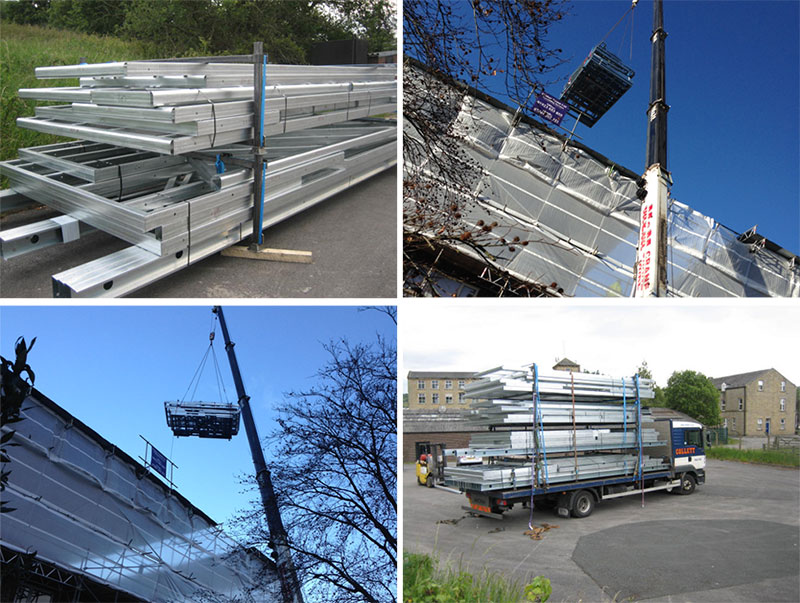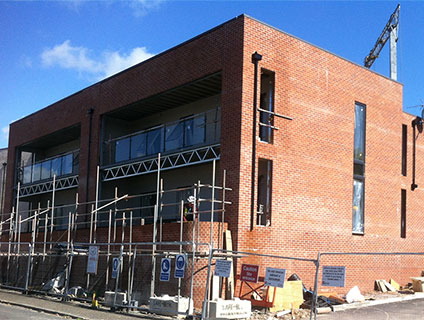
A growing Number of the self build enthausiasts and housebuilders are discovering that showing some steel really does have benefits when it comes to the construction of the residential roofing areas – allowing for saving to be made both financially and in the terms of the meeting ever reduced construction programmes.
Steel roofing structures have, until recently, been predominantly the preserve of industrial and commercial developments looking to make savings with a swift completion over tight timescales and budgets. Over the last two years more and more residential projects are finding that the U-Roof system has a number of key advantages over traditional timber roofing.
Launched in 2009, U-Roof is a bespoke CAD ‘Meccano’ style system involving u-shaped, cold rolled galvanised steel beams that fix easily together without the need for specialist skills or tools. It offers considerable savings on time and cost as well as offering almost instant precision and significantly more ‘room in the roof.
Designed by West Yorkshire-based engineer David Thurston, U-Roof is attracting attention and finding a ready market with everyone from self builders to the largest housebuilders in the UK as well as some of the most established architectural practices – all keen to benefit from the savings the system can offer.
It’s easy to see why as Neil Suggett, a self builder from Bristol currently engaged in constructing his new home, explained:
This is the first new-build my wife and I have ever undertaken and it’s involved the creation of a complex roof structure. Structural engineers recommended a steel frame to support cut timber rafters but I was faced with the dilemma of whether to go for a traditional steel fabrication service that could not guarantee the precision offered by a CAD-based solution or a fully bespoke, easily assembled system such as U-Roof. The former, traditional approach carried with it the risk of components not fitting precisely on site necessitating their return to the fabricators for adjustment work and more crane hire and labour to try to re-fit them after such work. The precision of the CAD based U-Roof system as well as its simple and swift installation and ability to cope with complexities such as raised eaves and multi-hips roof gave me the peace of mind of knowing exactly what I was getting. The U-Roof installation clearly offered the greatest cost savings overall. I made considerable calculated savings – if I had opted for a CAD designed, structural steel fabrication and installation by a specialist firm this would have been significantly more expensive than the “traditional approach” so that the total cost including timber joists and rafters would have been approximately double the U-Roof total cost.
The lightweight structure really appealed to me from a health and safety perspective and it’s perfectly suited to creating ‘room in the roof’ as it employs a warm roof design to maximise internal roof space.
What surprised me was quite how fast it fitted together. The joists, raised eaves uprights and the main rafters were assembled in position a day and a half after delivery by a four man team. Within a week all fixings were completed and the internal frames and panels fitted and work began on fixing the first layer of 90mm thick PIR insulation board to the outside of the roof rafters through counter battens and the insulation.
The raised eaves uprights were subsequently also insulated externally with 50mm thick PIR cavity insulation board and between the uprights with mineral wool insulation.
The U-Roof design service was first rate and they kept in touch on a regular basis. It’s difficult to make a comparison with traditional timbers due to my lack of experience but it generated a lot of interest amongst passing tradesman and one skilled carpenter who viewed it was genuinely impressed by its inherent flexibility, scalability and the potential to deal with complexities both on a bespoke and repetitive basis.
Another recent convert to the U-Roof revolution is Michael Dunn, MD of Bradford-based Stocksfield Construction who has utilised the system effectively at a residential project in Oakenshaw.
“The development consists of an extension and refurb to an existing bungalow dwelling as well as a detached new build. I heard about U-Roof by word of mouth from a trusted source. It took just a day to remove the old roof structure and erect the U-Roof structure including the floor and barely a week to seal up the dwelling – savings the benefited the construction program considerably. It offered a number of benefits over traditional attic trusses with a comprehensive and reassuring design service prior to delivery. We found it provided a safer working environment for our operatives, it eliminated the need for using a crane and it will be a definite requirement for the new dwelling.”
The U-Roof system exceeds all British targets for construction energy efficiency with insulation and is a perfect fit with the ethos and objectives of Modern Methods of Construction (MMC) as well as the Code for Sustainable Homes, a set of guidelines introduced in May 2008 that measures the sustainability of a new home against categories of sustainable design and rates the ‘whole home’ as a complete package.
There’s also no threat of infestation or warping and its lightweight nature offers significant health and safety benefits.
Michael added
“It ticks a lot of boxes when it comes to building a roof and I can see it featuring in a lot more developments over the coming years. We will be looking to use it on our Vulcan Street development of 19 houses in Bradford. It is a cost effective way of providing roof space accommodation.”
